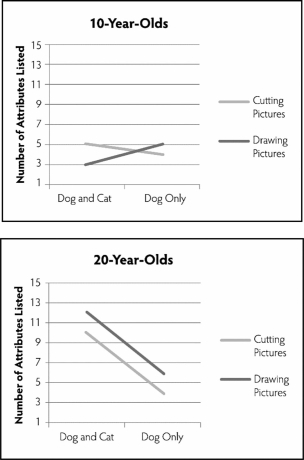(The first paragraph is repeated from earlier.The second paragraph is specific to the new set of questions.The first paragraph is necessary to set up the original study. )
Dr.Elder was interested in the way people recognize objects as members of categories.For example,what makes us recognize a dog as being a dog and not a cat? More specifically,he was curious as to whether people think about categories in a more complex way if they contemplate an "opposite" category first.For example,does a person think more differently about the category of "southern" if they are also thinking about the category of "northern"? He is also curious as to whether people categorize differently if they are exposed to category members compared with generating category members.Dr.Elder has four groups of participants (with 30 people in each group) .In Group A,participants were told to cut out pictures of dogs and cats from magazines.In Group B,participants were told to cut out pictures of just dogs from magazines.In Group C,participants were told to draw pictures of cats and dogs.In Group D,participants were told to draw pictures of just dogs.After doing this for 30 minutes,participants in all groups were asked to list the attributes that define the "dog" category.Having a higher number of attributes listed was considered to be an indication of thinking about the category in a more complex way.
Dr.Elder also is curious as to whether categorization happens similarly for children as it does for adults.As such,he recruits a group of 10-year-olds and a group of 20-year-olds to participate in the study.The results are below.

-In the study described above,Dr.Elder will need to examine ________ main effects and ________ interactions.
Definitions:
Purchasing-Power Parity
An economic principle positing that currency exchange rates reach equilibrium when the purchasing power in both countries involved is equal.
Depreciated
The decrease in value of an asset over time, often due to wear and tear or obsolescence.
Appreciated
A term often used in finance and economics to describe an increase in the value of an asset or currency.
Export
Items or services transported from one nation to another with the intent of being sold or traded.
Q8: Imagine that Dr.Lopez decides to add an
Q14: Dr. Rodriquez is considering conducting a study
Q16: What is the relationship between moderators and
Q16: Which of the following does NOT allow
Q25: Deci and Ryan (1985, 2001) have proposed
Q26: Provide two reasons a researcher would want
Q26: When examining an association claim using a
Q44: From a Time.com article entitled "Why Men
Q48: When determining whether a study should be
Q57: Dr. Rodriquez is considering conducting a study